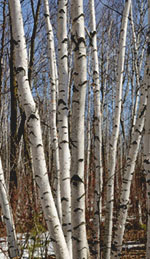 Pure birch essential oil is almost 100% methyl salicylate—the same therapeutic compound used in liniments to soothe muscle aches and painful joints—which may be why birch oil was a popular folk remedy for sore joints, sprains, and muscle aches caused by overexertion [1]. All parts of this beautiful tree have been used by people living in temperate Europe and North America—as a textile material, medicine, perfume, and even a food!
Pure birch essential oil is almost 100% methyl salicylate—the same therapeutic compound used in liniments to soothe muscle aches and painful joints—which may be why birch oil was a popular folk remedy for sore joints, sprains, and muscle aches caused by overexertion [1]. All parts of this beautiful tree have been used by people living in temperate Europe and North America—as a textile material, medicine, perfume, and even a food!
Several species of birch (genus Betula) can be found in temperate regions of the world; Betula alba is the species typically used to extract birch essential oil. Birches are small to medium-sized trees or shrubs with serrated leaves and characteristic smooth, shiny bark marked by horizontal oval strips called lenticels [2]. Birch bark can be white, yellow, silver, or black depending on the composition of essential oils in the bark tar; common names for different species of birch often use the color of the bark as a distinguishing characteristic.
The name “birch” is thought to derive from an Indo-European root meaning “to shine”, in reference to birch bark’s beautiful sheen [2]. The tough outer bark of the birch tree can be peeled off the trunk in papery sheets, and was used as a durable natural paper by people in continental Europe for hundreds if not thousands of years. In fact, the bark’s tar content makes it so resistant to decay that birch bark drawings dating from 1240-1260 CE have been recovered at archaeological sites near Novgorod, Russia [2]!
Besides being a valued paper analogue, the bark of the birch tree has been used by humans in fragrancing, medicine, and even food—the soft inner bark of the birch tree is edible and was eaten as a starch in times when other starch sources were scarce [1]. Interior birch bark may also have been used as the first “aspirin” in Europe and North America: the soft bark was steeped into a methyl salicylate-containing tea that was taken to treat headaches and congestion [1]. In Russia, birch oil was a jealously guarded fragrance and key component in “Russian Leather”, a perfume so-named because it was once rubbed into book bindings to keep the leather soft, water-resistant, and pliable, as well as to repel insects that could cause damage [1]. Ladies also scented their kerchiefs with a scent called Iceland Wintergreen that contained birch oil [1].
Today, aromatherapists use birch oil in many of the same applications as wintergreen oil: as a topical liniment for sore muscles, joints, and sprains, and in diffusion to treat headache and sinus congestion [3]. In Europe, birch essential oil is also one of the few essential oils approved to treat arthritis and other joint conditions in horses. Pure birch essential oil contains mostly methyl salicylate (the same active compound found in wintergreen oil), as well as creosol and guaiacol [1], which combined give pure birch oil an enchantingly fresh, minty scent!
Aromatherapists also use a drop or two of birch oil in a warm bath to soothe sore muscles, promote circulation and encourage menstruation, especially when the latter has been delayed due to stress or emotional issues [1]. Some people also find relief from the dry rough skin that accompanies eczema or psoriasis when birch oil is added to a lotion [1]. A small amount of birch oil may also be added to a shampoo or conditioner to combat dandruff [3].
Like wintergreen oil, birch oil is an oral toxin due to its high methyl salicylate content [3]. Birch essential oil should never be taken internally or used over large areas of the skin [3]. Birch oil is best used in diffusion from an oil burner or diffuser, or topically in extremely limited quantities. The oil’s refreshing, minty aroma blends exceptionally well with woody or floral oils such as jasmine, rose, benzoin, rosemary, and sandalwood.
REFERENCES
1. Keville, Kathy. “Aromatherapy: Birch”. HowStuffWorks. Accessed September 12th, 2014. http://health.howstuffworks.com/wellness/natural-medicine/aromatherapy/aromatherapy-birch.htm.
2.“Birch”. Wikipedia. Last modified September 9th, 2014. http://en.wikipedia.org/wiki/Birch.
3. “Health Benefits of Birch Essential Oil”. Organic Facts. Accessed September 12th, 2014. https://www.organicfacts.net/health-benefits/essential-oils/health-benefits-of-birch-essential-oil.html.
